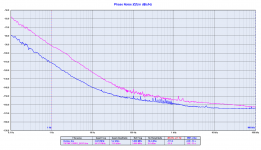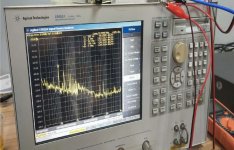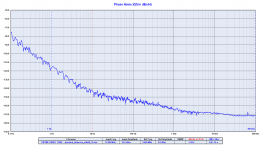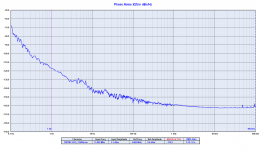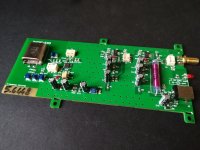Against all evidence the improvised RF engineer continues to argue the opposite of what has been empirically measured (altough he is measurements obsessed): "it is a fact that any common frequency divider introduces much more additive phase noise than they avoid by dividing the source".
Exactly the opposite since the ordinary divider has better phase noise than the source (plot attached again):
- 22 dB better at 0.1Hz from the carrier
- 20 dB better at 1 Hz from the carrier
- 18 dB better at 10 Hz from the carrier
- 8 dB better at 100 Hz from the carrier
- 5 dB better at 1kHz from the carrier
- 5 dB better at 10 kHz from the carrier
- 3 dB better noise floor
And a regenerative divider could do better, we will try it soon, almost ready.
But now the smart engineer does not trust the measurements.
The situation is increasingly sad.
BTW, no problem with thirdy party measurements, Joseph K has just received a pair of crystals and boards with individual phase noise plots so he can repeat the measurements.
And no problem even to send a board to Gerhard who will measure again it with the Timepod.
Of course is useless to send the board to the smart engineer since he does not own a suitable gear to measure the phase noise.
Exactly the opposite since the ordinary divider has better phase noise than the source (plot attached again):
- 22 dB better at 0.1Hz from the carrier
- 20 dB better at 1 Hz from the carrier
- 18 dB better at 10 Hz from the carrier
- 8 dB better at 100 Hz from the carrier
- 5 dB better at 1kHz from the carrier
- 5 dB better at 10 kHz from the carrier
- 3 dB better noise floor
And a regenerative divider could do better, we will try it soon, almost ready.
But now the smart engineer does not trust the measurements.
The situation is increasingly sad.
BTW, no problem with thirdy party measurements, Joseph K has just received a pair of crystals and boards with individual phase noise plots so he can repeat the measurements.
And no problem even to send a board to Gerhard who will measure again it with the Timepod.
Of course is useless to send the board to the smart engineer since he does not own a suitable gear to measure the phase noise.
Attachments
Last edited:
I won't cut open the Wenzel in my SR620 time interval counter, but I
can offer a peek inside a Morion MV89A if you want. But most of it is
the double oven, which is of less interest here.
Or a FEI 405 unit that I could open without grinding or soldering.
OK, not to the crystals. I still need it.
It has awful far-out output spectrum, but the carrier goes deep into
ADEV E-13 land at seconds to minutes (Low freq).
Both the Morion MV89A and the FE 405 are garbage in terms of phase noise (about 20dB worse) compared to what is claimed by these guys.
Poor guy, he doesn't have a proper tool to measure the phase noise. Unfortunately it doesn't go under 10MHz, so sometimes he has to use the other poor man's tool, the 89410A in phase demodulation mode.
The poor guy didn't read the manual of the E5052A or he knew how the cross
correlation thing with the 2 references works. But that worked much better in the E5052B.
The 1/f of my 89441A ( next gen 89410A) is so bad that I didn't even bother to
measure phase noise with it. Its intended use is to debug the modulation of
gen 3/4 cell phones, and the 25 MSPS 12 bit ADC shows.
The SC cut crystal in the Morion MV89A is actually quite OK. Q = 2.4Meg @ 5 MHz.
That does not change much between room and oven temperature, only the
frequency drifts more at room temp. This particular Morion ceased to oscillate
at Vtune > 0.5V, so it was clear that it was a candidate for autopsy.
< https://synergymwave.com/articles/2013/04/full_article.pdf >
< http://time.kinali.ch/rohde/noise/how_low_can_they_go-2013-poddar_rohde_apte.pdf >
Attachments
Last edited:
It looks like the smart engineer does not know he can design an up converter to measure below 10 MHz with the E5052.
However he can easily measure the DRIXO and the EXO at 11.2896 MHz with the Agilent to demonstrate the attached phase noise plots are not reliable if he think so.
It looks like the smart engineer does not know that at these level the crystal makes the difference, the electronic does not matter much although the Driscoll circuit has a few advantage.
But the smart engineer does not know what advantages.
He don't know that the MV89A and similar OCXO are designed for different applications, where long term stability and aging are essential.
Indeed they use a double oven to guarantee long term stability and probably a very low drive level to get the maximum aging performance.
The poor guys know these because they have experimented along the last 5 years around oscillators to get such performance.
They have found the optimal drive level of the crystal to get the best close in phase noise from the crystal.
They have inplemented the oven and they have measured the same oscillator (DRIXO at 5.6448 MHz) with and without the oven.
But since they don't care about the Allan deviation in audio application they have removed the oven because the is no difference in phase noise with and without it.
But the poor guys are very stupid, they have lost a lot of time while the smart engineer has the smart solution.
He has implemented a PLL, and it was enough obvious since he usually adopts tons of feedback.
Pity that the measure is a bit poor.
However he can easily measure the DRIXO and the EXO at 11.2896 MHz with the Agilent to demonstrate the attached phase noise plots are not reliable if he think so.
It looks like the smart engineer does not know that at these level the crystal makes the difference, the electronic does not matter much although the Driscoll circuit has a few advantage.
But the smart engineer does not know what advantages.
He don't know that the MV89A and similar OCXO are designed for different applications, where long term stability and aging are essential.
Indeed they use a double oven to guarantee long term stability and probably a very low drive level to get the maximum aging performance.
The poor guys know these because they have experimented along the last 5 years around oscillators to get such performance.
They have found the optimal drive level of the crystal to get the best close in phase noise from the crystal.
They have inplemented the oven and they have measured the same oscillator (DRIXO at 5.6448 MHz) with and without the oven.
But since they don't care about the Allan deviation in audio application they have removed the oven because the is no difference in phase noise with and without it.
But the poor guys are very stupid, they have lost a lot of time while the smart engineer has the smart solution.
He has implemented a PLL, and it was enough obvious since he usually adopts tons of feedback.
Pity that the measure is a bit poor.
Attachments
Last edited:
The poor guy didn't read the manual of the E5052A or he knew how the cross
correlation thing with the 2 references works. But that worked much better in the E5052B.
The 1/f of my 89441A ( next gen 89410A) is so bad that I didn't even bother to
measure phase noise with it. Its intended use is to debug the modulation of
gen 3/4 cell phones, and the 25 MSPS 12 bit ADC shows.
The SC cut crystal in the Morion MV89A is actually quite OK. Q = 2.4Meg @ 5 MHz.
That does not change much between room and oven temperature, only the
frequency drifts more at room temp. This particular Morion ceased to oscillate
at Vtune > 0.5V, so it was clear that it was a candidate for autopsy.
< https://synergymwave.com/articles/2013/04/full_article.pdf >
< http://time.kinali.ch/rohde/noise/how_low_can_they_go-2013-poddar_rohde_apte.pdf >
Admittedly I have not studied the E5052A manuals closely, but somehow I don't think they mention something that is not already well known for quite some time https://tf.nist.gov/general/tn1337/Tn190.pdf p.245 and the following (which I am sure you are aware of). Unfortunately I don't have a low noise double balanced mixer to use... and yes, I have no clue how to design one (and not planning to learn, life is too short, there's a bigger fish to fry for me) 😀. True, the E5052A is not that great compared to the E5052B. I wish I had an E5052B but, short of blind luck (which I already had with the acquisition of the E5052A, so...), that would require a second mortgage.
Your 89410A might have a problem. While indeed the noise floor is not that great (yes, the 12bit converters are poor in this respect), 1/f noise has nothing outstanding. It won't let you determine the low order Leeson constants, but for very low frequency measurements is good enough, see the screenshot I posted early, where the b-4 point is clearly visible, shortly before 0.1Hz.
The only difference between the 89440A and 89441A is the down converter. The 89440A is 1.8GHz, the 89441A goes to 2.65GHz. Other than that, the base band instrument (the 89410A) is the same, although I've seen an 89410E (if memory serves) that has a LCD screen and possible other improvements.
Neither do I. Since I am currently dabbling with oscillators, here's so far my best shot. A 0dB 6.144MHz sine, from a fractional PLL, using a MTI Series 225 VCOCXO (the best of the best, space grade, long live EBay, got it for almost free 😀).
Note: the chart shows L(f), to get S(f) add 3dB. -110dBrad^2 @1Hz and -124dB @ 10Hz is not too shabby, but a far cry from what they are claiming <-120dB @ 1Hz and <-148dB @ 10Hz, I haven't seen such numbers even for sapphire oscillators (normalized to frequency). Note the b-4 break shortly before 0.1Hz.
I've posted this here before but for your benefit 10MHz with 1Hz, -123dBc
10Hz, -148dBc. Full schematic in paper. You are welcome 🙂
TCD
Attachments
Indeed, as I already said, it's the starting point for the EXO oscillator, although we have made several changes to get it working with a single supply rail, we have added a pair of buffers and so on.
Of course, no PLL to get such performance (and several iterations for us).
Of course, no PLL to get such performance (and several iterations for us).
Attachments
Last edited:
Secondly, any sane "measurement obsessed" engineer would not trust your measurements on the so-called TWTMC-EXO (nice, catchy name, makes it look more interesting, BTW), until independently verified.
This nice, catchy named oscillator is developed by Andrea based on the above article, so now there are two subjects with suspended credibility until a good, trustable scientific scrutiny, the WhiteRose article and the TWTMC-EXO oscillator.
Who else get's on the list? 😀
This nice, catchy named oscillator is developed by Andrea based on the above article, so now there are two subjects with suspended credibility until a good, trustable scientific scrutiny, the WhiteRose article and the TWTMC-EXO oscillator.
Who else get's on the list? 😀
You should add the Pierce PXO at 6.144 MHz since the poor guys have measured -140dBc at 10 Hz from the carrier using an AT-Cut crystal.
But the poor guys are surely two cheaters.
Attachments
I've posted this here before but for your benefit 10MHz with 1Hz, -123dBc
10Hz, -148dBc. Full schematic in paper. You are welcome 🙂
Thanks, I've seen this before, did I ever said such an oscillator cannot be built?
I would kindly point you to the construction details in the paper, then compare them with a dangling PCB that is offered here. And please don't invoke "an oven is not required" argument, it's not only about stability, it's, as I already mentioned several times, about shielding, EMI, and other such issues that dominate at those levels.
This nice, catchy named oscillator is developed by Andrea based on the above article, so now there are two subjects with suspended credibility until a good, trustable scientific scrutiny, the WhiteRose article and the TWTMC-EXO oscillator.
Who else get's on the list? 😀
And what does the article prove, other than it is possible to design a good low noise oscillator? Does it prove in any way, shape or form your claimed performance?
But then you, your colleague, and a few others remind me of a pack of wild dogs, waiting for anybody raising reasonable doubts, or making suggestions, to maul them good. Good luck promoting this BS for audio, good luck with the sales to the (for you) useful idiots that are the innocent audiophiles. I'm out of here, be happy.
I am not sure where all this anger came from or the need to insult those of us who value this group buy. But leaving may be the best option if you cannot be constructive.
Now the poor guys don't even know how to design a RF PCB, they have to learn from the smart engineer.
But the poor guys are lucky again because the performances they got with such dangling PCB are remarkable.
And looking at the plot, EMI and other such issues don't dominate at those levels.
But by now we know, the poor guys are lucky or maybe they are just cheaters.
At the end the smart engineer has published a poor oscillator with poor measurement (using a PLL!) and now he goes away with his tail between his legs.
And obviously insulting everything and everyone.
Maybe he's not so smart.
But the poor guys are lucky again because the performances they got with such dangling PCB are remarkable.
And looking at the plot, EMI and other such issues don't dominate at those levels.
But by now we know, the poor guys are lucky or maybe they are just cheaters.
At the end the smart engineer has published a poor oscillator with poor measurement (using a PLL!) and now he goes away with his tail between his legs.
And obviously insulting everything and everyone.
Maybe he's not so smart.
D
Deleted member 537459
And what does the article prove, other than it is possible to design a good low noise oscillator? Does it prove in any way, shape or form your claimed performance?
But then you, your colleague, and a few others remind me of a pack of wild dogs, waiting for anybody raising reasonable doubts, or making suggestions, to maul them good. Good luck promoting this BS for audio, good luck with the sales to the (for you) useful idiots that are the innocent audiophiles. I'm out of here, be happy.
I don't now who you are, but I think is not the best issue for open a discussing. You flaming, have you make somethings or you are just offensive with the people work and contribute with passion. I think is better you find another place to flame... bye
A quick first report of the TWTMC DRIXO (11MHz and 12MHz) Compared with TWTMC-D DRISCOLL (even frequency)
It is very positive, the space and the dynamics between the different instruments is increased, so we have a wider and deep sound scene, on certain pieces like for example 'Woman in Chains' of Tears for Fears, recording is such that it can quickly become aggressive and thrown forward, nothing of this with the Drixo, the voices are not aggressive or thrown forward, they stay there or they must be, but what immediately impresses me It is the quality of the bass sector it's very dynamic.
I will put the card in a chassis and leave the crystal to break and I would take a report
Andrea Thank you for this experience and all your work .
It is very positive, the space and the dynamics between the different instruments is increased, so we have a wider and deep sound scene, on certain pieces like for example 'Woman in Chains' of Tears for Fears, recording is such that it can quickly become aggressive and thrown forward, nothing of this with the Drixo, the voices are not aggressive or thrown forward, they stay there or they must be, but what immediately impresses me It is the quality of the bass sector it's very dynamic.
I will put the card in a chassis and leave the crystal to break and I would take a report
Andrea Thank you for this experience and all your work .
Last edited:
A quick first report of the TWTMC DRIXO (11MHz and 12MHz) Compared with TWTMC-D DRISCOLL (even frequency)
...
The way I read it, this is the second report out (thankyou) indicating perceived sound quality significantly better than the already great Driscoll from the last GB. That is pretty promising. While the hotly debated measurements are important to the development, it is the subjective sound quality that is the important measure of success.
- Status
- Not open for further replies.
- Home
- Source & Line
- Digital Line Level
- The Well Tempered Master Clock - Building a low phase noise/jitter crystal oscillator
